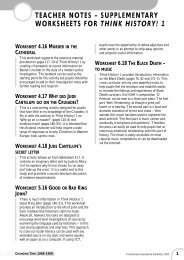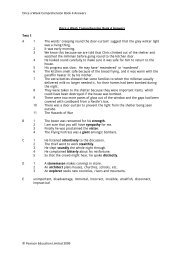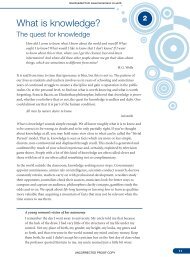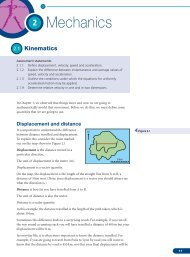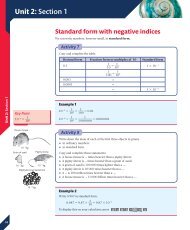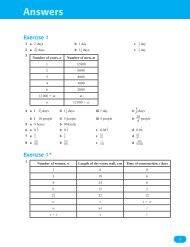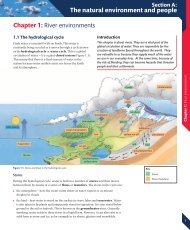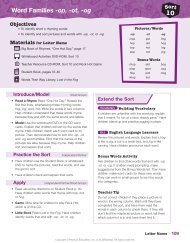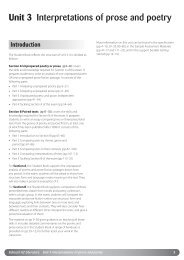Scope and Sequence Interactive Science grades 6-8 - Pearson
Scope and Sequence Interactive Science grades 6-8 - Pearson
Scope and Sequence Interactive Science grades 6-8 - Pearson
You also want an ePaper? Increase the reach of your titles
YUMPU automatically turns print PDFs into web optimized ePapers that Google loves.
<strong>Science</strong> <strong>and</strong> TechnologyChapter 1. What Is <strong>Science</strong>?1. <strong>Science</strong> <strong>and</strong> the Natural World2.Thinking Like a Scientist3. Scientific Inquiry<strong>Scope</strong> <strong>and</strong> <strong>Sequence</strong><strong>Interactive</strong> <strong>Science</strong> <strong>grades</strong> 6-8Chapter 2. <strong>Science</strong>, Society, <strong>and</strong> You1. Why Study <strong>Science</strong>?2. Scientific Literacy3. Scientists <strong>and</strong> Society4. Careers in <strong>Science</strong>Chapter 3. The Tools of <strong>Science</strong>1. Measurement—A Common Language2. Mathematics <strong>and</strong> <strong>Science</strong>3. Graphs in <strong>Science</strong>4. Models as Tools in <strong>Science</strong>5. Safety in the <strong>Science</strong> LaboratoryChapter 4. Technology <strong>and</strong> Engineering1. Underst<strong>and</strong>ing Technology2. Technological Design3. Technology <strong>and</strong> Society4. EngineeringEarth’s StructureChapter 1. Introducing Earth1. The Earth System2. Earth’s Interior3. Convection <strong>and</strong> the MantleChapter 2. Minerals <strong>and</strong> Rocks1. Properties of Minerals2. Classifying Rocks3. Igneous Rocks4. Sedimentary Rocks5. Metamorphic Rocks6. The Rock Cycle
Chapter 3. Plate Tectonics1. Drifting Continents2. Sea-Floor Spreading3. The Theory of Plate TectonicsChapter 4. Earthquakes1. Forces in Earth’s Crust2. Earthquakes <strong>and</strong> Seismic Waves3. Monitoring EarthquakesChapter 5. Volcanoes1. Volcanoes <strong>and</strong> Plate Tectonics2. Volcanic Eruptions3. Volcanic L<strong>and</strong>formsEarth’s SurfaceChapter 1. Mapping Earth’s Surface1. Exploring Earth’s Surface2. Models of Earth3. Mapping Technology4. Topographic MapsChapter 2. Weathering <strong>and</strong> Soil1. Rocks <strong>and</strong> Weathering2. How Soil Forms3. Soil ConservationChapter 3. Erosion <strong>and</strong> Deposition1. Mass Movement2. Water Erosion3. Glacial Erosion4. Wave Erosion5. Wind ErosionChapter 4. A Trip Through Geologic Time1. Fossils2. The Relative Age of Rocks3. Radioactive Dating4. The Geologic Time Scale5. Early Earth6. Eras of Earth’s History
Water <strong>and</strong> the AtmosphereChapter 1. Fresh Water1. Water on Earth2. Surface Water3. Water Underground4. Wetl<strong>and</strong> EnvironmentsChapter 2. The Oceans1. Exploring the Ocean2. Wave Action3. Currents <strong>and</strong> Climate4. Ocean HabitatsChapter 3. The Atmosphere1. The Air Around You2. Air Pressure3. Layers of the Atmosphere4. Energy in Earth’s Atmosphere5. Heat Transfer6. WindsChapter 4. Weather1. Water in the Atmosphere2. Clouds3. Precipitation4. Air Masses Core5. Storms6. Predicting the WeatherChapter 5. Climate <strong>and</strong> Climate Change1. What Causes Climate?2. Climate Regions3. Changes in Climate4. Human Activities <strong>and</strong> Climate ChangeAstronomy <strong>and</strong> Space <strong>Science</strong>Chapter 1. Earth, Moon, <strong>and</strong> Sun1. The Sky from Earth
2. Earth in Space3. Gravity <strong>and</strong> Motion4. Phases <strong>and</strong> Eclipses5. Tides6. Earth’s MoonChapter 2. Exploring Space1. The <strong>Science</strong> of Rockets2. The History of Space Exploration3. Using Space <strong>Science</strong> on EarthChapter 3. The Solar System1. Models of the Solar System2. Introducing the Solar System3. The Sun4. The Inner Planets5. The Outer Planets6. Small Solar System ObjectsChapter 4. Stars, Galaxies, <strong>and</strong> the Universe1. Telescopes2. The Scale of the Universe3. Characteristics of Stars4. Lives of Stars5. Star Systems <strong>and</strong> Galaxies6. The Exp<strong>and</strong>ing UniverseEcology <strong>and</strong> the EnvironmentChapter 1. Populations <strong>and</strong> Communities1. Living Things <strong>and</strong> the Environment2. Populations3. Interactions Among Living Things4. Changes in CommunitiesChapter 2. Ecosystems <strong>and</strong> Biomes1. Energy Flow in Ecosystems2. Cycles of Matter3. Biomes4. Aquatic Ecosystems5. Biogeography
Chapter 3. Resources <strong>and</strong> Living Things1. Introduction to Environmental Issues2. Introduction to Natural Resources3. Human Population Growth4. Forests <strong>and</strong> Fisheries5. BiodiversityChapter 4. L<strong>and</strong>, Air, <strong>and</strong> Water Resources1. Conserving L<strong>and</strong> <strong>and</strong> Soil2. Waste Disposal <strong>and</strong> Recycling3. Air Pollution <strong>and</strong> Solutions4. Water Pollution <strong>and</strong> Solutions5. Ocean ResourcesChapter 5. Energy Resources1. Fossil Fuels2. Renewable Sources of Energy3. Energy Use <strong>and</strong> ConservationCells <strong>and</strong> HeredityChapter 1. Introduction to Cells1. Discovering Cells2. Looking Inside Cells3. Chemical Compounds in Cells4. The Cell in Its EnvironmentChapter 2. Cell Processes <strong>and</strong> Energy1. Photosynthesis2. Cellular Respiration3. Cell DivisionChapter 3. Genetics: The <strong>Science</strong> of Heredity1. What Is Heredity?2. Probability <strong>and</strong> Heredity3. Patterns of Inheritance4. Chromosomes <strong>and</strong> InheritanceChapter 4. DNA: The Code of Life1. The Genetic Code2. How Cells Make Proteins
3. MutationsChapter 5. Human Genetics <strong>and</strong> Genetic Technology1. Human Inheritance2. Human Genetic Disorders3. Advances in Genetics4. Using Genetic InformationChapter 6. Change Over Time1. Darwin’s Theory2. Evidence of Evolution3. Rate of ChangeThe Diversity of LifeChapter 1. Introduction to Living Things1. What Is Life?2. Classifying Life3. Domains <strong>and</strong> Kingdoms4. Evolution <strong>and</strong> ClassificationChapter 2. Viruses, Bacteria, Protists, <strong>and</strong> Fungi1. Viruses .2. Bacteria3. Protists4. FungiChapter 3. Plants1. What Is a Plant?2. Classifying Plants3. Plant Structures4. Plant Reproduction5. Plant Responses <strong>and</strong> Growth6. Plants in Everyday LifeChapter 4. Introduction to Animals1. What Is an Animal?2. Animal Body Plans3. Introduction to Invertebrates4. Introduction to Vertebrates5. Vertebrate Diversity
Chapter 5. Getting Around1. Skeletons <strong>and</strong> Muscles2. Nervous System3. Animal MovementChapter 6. Obtaining Energy1. How Animals Obtain <strong>and</strong> Digest Food2. How Animals Obtain Oxygen3. Circulation <strong>and</strong> ExcretionChapter 7. Animal Reproduction <strong>and</strong> Behavior1. Animal Reproduction <strong>and</strong> Fertilization2. Development <strong>and</strong> Growth3. What Is Behavior?4. Patterns of BehaviorHuman Body SystemsChapter 1. The Human Body1. Body Organization2. System Interactions3. HomeostasisChapter 2. Bones Muscles, <strong>and</strong> Skin1. The Skeletal System2. The Muscular System3. The SkinChapter 3. Digestion1. Food <strong>and</strong> Energy2. Healthy Eating3. The Digestive Process Begins4. Final Digestion <strong>and</strong> AbsorptionChapter 4. Circulation1. The Body’s Transport System2. A Closer Look at Blood Vessels3. Composition of Blood4. Cardiovascular HealthChapter 5. Respiration <strong>and</strong> Excretion1. The Respiratory System
2. Smoking <strong>and</strong> Your Health3. The Excretory SystemChapter 6. Fighting Disease1. Infectious Disease2. The Body’s Defenses3. HIV <strong>and</strong> AIDS4. Infectious Disease <strong>and</strong> Your Health5. Noninfectious DiseaseChapter 7 The Nervous System1. How the Nervous System Works2. Divisions of the Nervous System .3. Sight <strong>and</strong> Hearing4. Smell, Taste, <strong>and</strong> Touch5. Alcohol <strong>and</strong> Other DrugsChapter 8. The Endocrine System <strong>and</strong> Reproduction1. The Endocrine System2. The Male <strong>and</strong> Female Reproductive Systems3. Pregnancy <strong>and</strong> Birth4. The Human Life CycleIntroduction to ChemistryChapter 1. Introduction to Matter1. Describing Matter2. Classifying Matter3. Measuring Matter4. Changes in MatterChapter 2. Solids, Liquids, <strong>and</strong> Gases1. States of Matter2. Changes of State3. Gas BehaviorChapter 3. Elements <strong>and</strong> the Periodic Table1. Introduction to Atoms2. Organizing the Elements3. Metals4. Nonmetals <strong>and</strong> Metalloids5. Radioactive Elements
Chapter 4. Atoms <strong>and</strong> Bonding1. Atoms, Bonding, <strong>and</strong> the Periodic Table2. Ionic Bonds3. Covalent Bonds4. Bonding in MetalsChapter 5. Chemical Reactions1. Observing Chemical Change2. Describing Chemical Reactions3. Controlling Chemical ReactionsChapter 6. Acids, Bases, <strong>and</strong> Solutions1. Underst<strong>and</strong>ing Solutions2. Concentration <strong>and</strong> Solubility3. Describing Acids <strong>and</strong> Bases4. Acids <strong>and</strong> Bases in SolutionForces <strong>and</strong> EnergyChapter 1. Motion1. Describing Motion2. Speed <strong>and</strong> Velocity3. AccelerationChapter 2. Forces1. The Nature of Force2. Friction <strong>and</strong> Gravity3. Newton’s Laws of Motion4. Momentum5. Free Fall <strong>and</strong> Circular MotionChapter 3. Work <strong>and</strong> Machines1. Work <strong>and</strong> Power2. Underst<strong>and</strong>ing Machines3. Inclined Planes <strong>and</strong> Levers4. Putting Machines TogetherChapter 4. Energy1. What Is Energy?2. Forms of Energy3. Energy Transformations <strong>and</strong> Conservation
Chapter 5. Thermal Energy <strong>and</strong> Heat1. Temperature, Thermal Energy, <strong>and</strong> Heat2. The Transfer of Heat3. Thermal PropertiesChapter 6. Electricity1. Electric Charge <strong>and</strong> Static Electricity2. Electric Current3. Electric Circuits4. Electric Power <strong>and</strong> SafetyChapter 7. Magnetism <strong>and</strong> Electromagnetism1. What Is Magnetism?2. Magnetic Fields3. Electromagnetic Force4. Electricity, Magnetism, <strong>and</strong> Motion5. Electricity from MagnetismSound <strong>and</strong> LightChapter 1. Characteristics of Waves1. What Are Waves?2. Properties of Waves3. Interactions of WavesChapter 2. Sound1. The Nature of Sound2. Properties of Sound3. Music4. Hearing Sound5. Using SoundChapter 3. Electromagnetic Waves1. The Nature of Electromagnetic Waves2. Waves of the Electromagnetic Spectrum3. Wireless CommunicationChapter 4. Light1. Light <strong>and</strong> Color2. Reflection <strong>and</strong> Mirrors3. Refraction <strong>and</strong> Lenses4. Seeing Light5. Using Light



